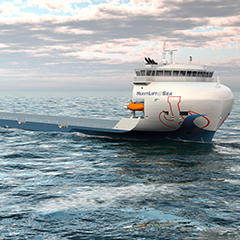Small port, big cargo, narrow waterways: the heavy cargo deck carrier for offshore wind projects in the North and Baltic Seas, which is currently being built at a Chinese shipyard, is the answer to a wide range of customer requirements for this special ship that initially seemed to be difficult to reconcile. The Hamburg maritime engineering company HeavyLift@Sea presented the solution with an individual basic design for a high-performance heavy cargo deck carrier.
“Our client for this project, a Hamburg-based shipping company specialising in offshore wind projects, is already operating a deck carrier, which is to be supplemented by a more flexible high-performance new-build. The ship will initially transport wind power components for offshore wind turbines in the North Sea and Baltic Sea,” says Hendrik Gröne, Managing Director of HeavyLift@Sea, explaining the project. This special area of application and the special ship’s type of employment required a very sophisticated, tailor-made design.
The heavy cargo deck carrier (DC 10000) has been designed to transport heavy cargo and large modules as well as components that cannot be lifted by crane due to their weight or structure – for example fragile steel structures for the oil and gas industry – but are rolled onto the loading deck. Since the ports at which the ship will call include a very small one in Denmark, the HeavyLift@Sea team simulated these conditions at the Danish shipbuilding test facility in Copenhagen and included the result in the design’s calculations. “There were a number of requirements for this ship that seemed to be mutually exclusive at first,” reports Hendrik Gröne. “The width of the required cargo deck had to be reconciled with a ship width that was small enough for the approach to this particularly small Danish port. At the same time, in order for the ship to pass through the Kiel Canal, it had to be taken into account that the deck couldn’t be wider than the waterline.”
Hamburg engineering company HeavyLift@Sea presents basic design for ambitious heavy cargo deck carrier




























